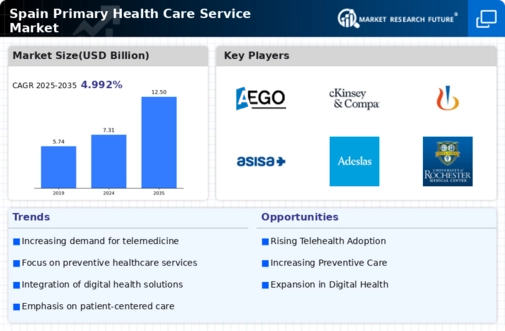Rising Aging Population
The demographic shift towards an older population in Spain is a crucial driver for the primary health-care-service market. As the population aged 65 and over is projected to reach 25% by 2030, the demand for health services tailored to chronic conditions and geriatric care is likely to increase. This demographic trend necessitates a robust primary health-care-service market to address the unique health needs of older adults. Furthermore, the increasing prevalence of age-related diseases such as diabetes and cardiovascular conditions further emphasizes the need for accessible primary health care. The Spanish government has recognized this trend, allocating approximately €10 billion annually to enhance health services for the elderly, thereby stimulating growth in the primary health-care-service market.
Government Policy Reforms
Recent government policy reforms aimed at improving healthcare access and quality are pivotal for the primary health-care-service market. The Spanish government has implemented various initiatives to enhance the efficiency of health services, including the introduction of new funding models and incentives for primary care providers. These reforms are designed to reduce waiting times and improve patient satisfaction, which are critical factors in the healthcare experience. As a result, the primary health-care-service market is expected to benefit from increased investment and support, potentially leading to a 15% growth in service availability over the next five years.
Increased Health Awareness
There is a growing awareness of health and wellness among the Spanish population, which is significantly impacting the primary health-care-service market. Public campaigns promoting healthy lifestyles and preventive care are leading to increased demand for regular health check-ups and screenings. According to recent surveys, approximately 60% of Spaniards now prioritize preventive health measures, which has resulted in a surge in visits to primary care providers. This shift towards proactive health management is likely to drive the expansion of services offered within the primary health-care-service market, as providers adapt to meet the evolving needs of health-conscious consumers.
Rising Chronic Disease Prevalence
The increasing prevalence of chronic diseases in Spain is a significant driver for the primary health-care-service market. Conditions such as obesity, hypertension, and respiratory diseases are on the rise, necessitating comprehensive management strategies within primary care settings. Current estimates suggest that over 30% of the Spanish population suffers from at least one chronic condition, which places a substantial burden on healthcare resources. This trend underscores the need for enhanced primary health-care services that focus on disease prevention, management, and patient education. Consequently, healthcare providers are likely to expand their offerings to accommodate the growing demand for chronic disease management, thereby fostering growth in the primary health-care-service market.
Technological Advancements in Healthcare
Technological innovations are transforming the primary health-care-service market in Spain. The integration of electronic health records (EHRs), mobile health applications, and artificial intelligence (AI) in diagnostics and treatment planning is enhancing service delivery. For instance, the adoption of EHRs has increased by 40% in recent years, facilitating better patient management and data sharing among healthcare providers. Additionally, telemedicine platforms are gaining traction, allowing patients to access primary care remotely, which is particularly beneficial in rural areas. These advancements not only improve patient outcomes but also streamline operations within the primary health-care-service market, potentially reducing costs by up to 20%.



















Leave a Comment